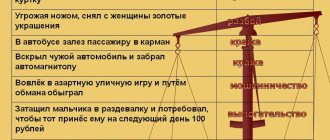Criminal law. A special part. Short course
1. Murder. Qualified types of murder
1.
The generic object
of murder is the person.
Species object
murders are human life and health.
Direct object
murder is the life of a specific person.
2.
The objective side
is characterized by causing death to another person and consists of three elements:
• act (action or inaction). The act can be either active (for example, shooting, hitting, strangling) or passive behavior (for example, a mother deliberately does not feed her newborn child, wanting to get rid of him);
• criminal consequences. Such consequences in case of murder are the biological death of the victim. This sign of the objective side is mandatory, since this crime is material;
• causal connection between the act and the consequence.
3.
The subjective side
testifies to the mental attitude of the subject to his actions and the resulting death of the victim.
The subjective side is characterized by guilt in the form of intent or negligence. Intent in murder can be either direct or indirect.
Establishing the distinction between direct and indirect intent is of great importance for distinguishing attempted murder from other crimes.
Attempted murder is only possible with direct intent.
4.
The motive
and
purpose
of the crime act as mandatory features, since the qualification of murder depends on their content.
Motives can be different: personal hostility, jealousy, envy, etc.
The purpose of the crime is to take life.
5.
The crime is considered
completed
when the death of the person results from the act of the perpetrator.
6.
Murders are divided into three groups:
• committed without aggravating or mitigating circumstances;
• committed under aggravating circumstances;
• committed under extenuating circumstances.
7.
Qualified murders are:
• two or more persons;
• a person or his relatives in connection with the performance of official activities by this person or the performance of public duty;
• a minor or other person who is known to the perpetrator to be in a helpless state, as well as associated with the kidnapping of a person;
• women who are known to the perpetrator to be pregnant;
• committed with particular cruelty; in a generally dangerous manner; based on blood feud; a group of persons; a group of persons by prior conspiracy or an organized group; for mercenary reasons or for hire, as well as murder associated with robbery, extortion or banditry; for hooligan reasons; in order to hide another crime or facilitate its commission, as well as involving rape or sexual assault; for reasons of political, ideological, racial, national or religious hatred or enmity, or for reasons of hatred or enmity towards any social group; for the purpose of using the victim’s organs or tissues.
8.
The subject of a murder
is a sane individual who was 14 years old when the murder was committed.
2. Murder committed in a state of passion
1.
Most often, this type of murder is characterized by a special emotional state of a person, which is an extremely strong short-term emotional arousal, an outburst of emotions such as fear, anger, rage, despair, proceeds violently and is characterized by suddenness of occurrence, short duration of the course, significant changes in consciousness, disturbance volitional control of actions.
Murder in a state of passion is usually committed immediately after exposure to an irritating factor. There is no time gap here, or it is insignificant.
2.
Violence
can be both physical (for example, beating) and mental (threats to cause harm to health).
Mockery
can be expressed in humiliation of human dignity, mockery of the individual.
Serious insult
is expressed in gross humiliation of the honor and dignity of a person, which is most often expressed in an indecent form.
To other illegal actions
These include such behavioral acts that, although they do not constitute violence, bullying, or insult, are nevertheless characterized by a gross violation of the rights and legitimate interests of the perpetrator and other persons.
Immoral actions (inaction)
represent actions contrary to moral norms that may be the reason for the emergence of a state of passion (for example, adultery).
The affect in which a murder is committed can be caused not only by an unexpected circumstance provided for by law, but also by a long-term psychologically traumatic situation,
arising in connection with the systematic illegal or immoral behavior of the victim. This situation includes violence, bullying, grave insult, immoral acts, systematic illegal or immoral behavior of the victim.
3.
Mitigation of liability for this type of murder is due to the fact that the perpetrator acts in a special mental state caused by the provocative nature of the victim’s behavior.
4.
Affect can be:
• physiological,
in which the ability of self-control is retained to a certain extent. Although the person’s volitional control over his actions is underestimated, it still exists. Physiological affect does not exclude the sanity of a person and is recognized as a circumstance that significantly reduces the degree of public danger of a murder committed by a person. Physiological affect is characterized by a violent and short-term course, suddenness of occurrence, underestimation of conscious volitional control over one’s behavior, narrowing of consciousness;
• pathological,
in which a person completely loses the ability to consciously control his actions. Pathological affect indicates a person’s insanity.
5.
The subjective side
is characterized by direct or indirect intent.
6.
A qualified type
of passion is the murder of two or more persons.
7.
The subject of
a murder in a state of passion is a sane individual who has reached the age of 16 years.
3. Beatings. Torture
1.
The generic object
is social relations in the sphere of ensuring personal security.
Species object
– social relations that provide a person with the right to use his health.
Direct object
social relations should be recognized that ensure the human right to physical (bodily) integrity.
Murder and its differentiation from related crimes.
Murder , that is, intentionally causing the death of another person.
Crimes related to murder are those that have features similar to those enshrined in the rules on murder. At the same time, they have differences that allow them to be qualified under other articles of the Criminal Code of the Russian Federation.
It seems that the main similarity between murders and related crimes is the death of the victim as a result of the act of the perpetrator. The differences can be grouped as follows: 1) in the form of a person’s guilt to the consequences; 2) in the specific object of encroachment; 3) both in the form of a person’s guilt to the consequences, and in the specific object of the attack.
Composition of murder: material. Complete murder takes place only in cases where the result of the perpetrator’s act was the death of a person.
Object of crime
A generic object (murder, Article 105 of the Criminal Code of the Russian Federation) constitutes social relations that ensure basic (natural) human rights and freedoms, in particular the fundamental right - the right to life (a generic object).
A species object represents social relations that ensure a fundamental right – the right to life.
The immediate object is the right of a particular person to life.
Objective side of the crime
The objective side of murder is the deprivation of the life of another person in a certain, illegal way. Murder can be committed either in the form of action or in the form of inaction.
The subjective side of the crime: is characterized exclusively by guilt in the form of intent. Intention in this case can be both direct and indirect.
Subject of the crime: can be any person who at the time of the commission of the crime has reached the age of fourteen years.
Murder must be distinguished from causing death by negligence.
Particular difficulties arise in judicial practice when distinguishing murder with indirect intent from causing death through frivolity. In both cases, the perpetrator does not want such a result to occur and does not strive for it. But with indirect intent, the perpetrator deliberately allows death to occur, often treats this with indifference, and does not take any actions aimed at preventing such a result. In case of negligence in the form of frivolity, the perpetrator does not treat the death of the victim with indifference; he relies on his own strength, skill, dexterity, professional skill, and on the fact that as a result of the measures taken by him or as a result of the actions of other persons or any other specific factors, he will be able to avoid fatal outcome. However, due to the fact that the perpetrator in these cases does not show due diligence and does not sufficiently take into account his or her capabilities or the capabilities of other persons, a fatal result still occurs.
Causing death is considered committed through negligence if a person did not foresee the possibility of death from his actions (inaction), although with the necessary care and forethought he should and could have foreseen this.
It is necessary to distinguish between murder and intentional infliction of grievous bodily harm resulting in the death of the victim.
According to Art. 105 of the Criminal Code of the Russian Federation, it is a crime to intentionally cause the death of another person. Main object - Life
According to Part 4 of Art. 111 of the Criminal Code of the Russian Federation, the crime is the intentional infliction of grievous bodily harm, resulting through negligence in the death of the victim. The main object of a criminal attack is the health of the person who has been attacked by the perpetrator.
In paragraph 3 of the Resolution of the Plenum of the Supreme Court of the Russian Federation of January 27, 1999 No. 1 “On judicial practice in cases of murder (Article 105 of the Criminal Code of the Russian Federation)” it is stated that it is necessary to distinguish murder from the intentional infliction of grievous bodily harm resulting in the death of the victim, bearing in mind that in case of murder the intent of the perpetrator is aimed at depriving the victim of life, and when committing a crime under Part 4 of Art. 111 of the Criminal Code of the Russian Federation, the attitude of the perpetrator towards the death of the victim is expressed in negligence.
When deciding the direction of the intent of the perpetrator, one should proceed from the totality of all the circumstances of the crime and take into account, in particular, the method and weapon of the crime, the number, nature and location of bodily injuries (for example, injuries to vital organs of a person), as well as the previous crime and subsequent behavior of the perpetrator and the victim, their relationship.
SUBJECTIVE SIGNS OF MURDER OF A PERSON KNOWLEDGED TO BE GUILTY IN A HELPLESS STATE
As is known, the subjective characteristics of a crime include the subject and the subjective side. The subject of a crime in the science of criminal law is understood as a person who has committed an unlawful, socially dangerous act, capable of bearing criminal liability for it [8, p. 110]. According to Art. 19 of the Criminal Code of the Russian Federation, this person must be natural, reach the age of criminal responsibility and be sane. It is these signs that form the legal structure of the subject of the crime.
According to the general rule, the subject of criminal liability is a person who has reached the age of 16, however, the legislator in Part 2 of Art. 20 of the Criminal Code of the Russian Federation recognizes murder as such an act, the ability to understand the social significance of which is presumed from an early age. This means that responsibility for both simple murder and its qualified form (the murder of a person known to the perpetrator to be in a helpless state) begins at the age of 14.
A.A. Toporkov, in relation to murder, distinguishes two types of criminals: a) persons who committed the so-called. “domestic” murders as a result of family, work or everyday conflicts; b) persons who pose a great danger to society, because they commit murder with premeditated intent according to a meticulously developed plan, with selfish or other base goals in mind. Among them you can find repeat offenders who have made murder their profession [7, p. 345].
Almost all murder cases require special, including expert, research and assessment of the mental state of the accused when committing a crime from the position of sanity or insanity (Article 21 of the Criminal Code of the Russian Federation), as well as regarding a possible mental disorder that does not exclude sanity (Article 22 of the Criminal Code of the Russian Federation).
The subjective side of a crime in the theory of criminal law is the mental activity of a person directly related to the commission of a crime, and is the internal essence of any crime [9, p. 309]. This term is not used in criminal law, but the legislator reveals it using concepts such as “guilt”, “motive”, “purpose”, which characterize the mental essence of the subject’s behavior from different sides.
From the subjective side, any murder presupposes the presence of direct or indirect intent to cause death. A.A. Ghukasyan rightly writes that any murder can be committed with any kind of intent. With direct intent, the perpetrator is fully aware of the nature and degree of social danger of his actions to take the life of another person in connection with the commission of kidnapping, foresees the possibility or inevitability of the occurrence of socially dangerous consequences in the form of the death of a person and desires their occurrence. With indirect intent, the perpetrator is aware of the nature and degree of social danger of his actions to take the life of another person in connection with the commission of kidnapping, foresees the possibility of socially dangerous consequences in the form of the death of a person, does not want, but consciously allows them to occur or is indifferent to them [1 , c. 14]. At the same time, this category of murders is for the most part characterized by direct intent, in the implementation of which the criminal wants to take the life of a specific person, whose helpless state he knows in advance.
The term “motive” comes from the Latin word motum (“motor”), i.e. what motivates people in their activities. The motive for murder should be understood as a person’s conscious motivation to commit murder, the source of his actions, formed depending on the specific circumstances to be established during the preliminary investigation. A motive, as a more or less clear impulse for a specific action, is generated by various internal and external factors. They can be called motive-forming. These factors include the needs, interests, values of the subject, conflict situations and other objective and subjective circumstances.
Paragraph 4 of the Resolution of the Plenum of the Supreme Court of the Russian Federation dated January 27, 1999 No. 1 “On judicial practice in murder cases” lists the following possible motives for its commission: revenge, envy, hostility, hatred, on the basis of personal relationships, in a quarrel or fight. There are, of course, other motives, for example, jealousy, eliminating obstacles, self-interest, etc.
Motive is a moral category; it is always positioned in the field of ethical and moral relations, and this feature cannot be ignored. Taking into account the socio-psychological content and moral and ethical assessment, V.P. Kashepov proposes to distinguish the following groups of motives: 1) motives with ideological and political overtones; 2) base motives, which are forms of selfishness; 3) motives that are devoid of base content [3, p. 118].
At the same time, the motives of the crime (in fact, as well as its goals) are not taken into account when qualifying the offense under paragraph “c” of Part 2 of Art. 105 of the Criminal Code of the Russian Federation, however, they may be important for the additional qualification of the actions of the criminal under the article (part of the article) of the Criminal Code of the Russian Federation of which they are an important component. In paragraph 1 of the resolution of the Plenum of the Supreme Court of the Russian Federation “On judicial practice in cases of murder” on this matter, in particular, it is stated that in each case of murder, all circumstances are subject to careful clarification, including the motives, purpose and method of murder, since they are of utmost importance for the correct qualification of the crime committed by the perpetrator, as well as the assignment of a fair punishment to him.
In a helpless state, victims are unable, due to their physical or mental state, to defend themselves, to actively resist the killer, or to avoid reprisals, which is realized by the perpetrator. As a result, the commission of a crime becomes easier, the possibility of causing harm increases; as long as we are talking about persons in need of special protection, attentiveness, care, the crime reflects such aspects of the personality of the perpetrator as his exceptional immorality and heartlessness [6, p. 201].
When qualifying an act as the murder of a person who is known to be in a helpless state by the perpetrator, it should be borne in mind that not only the objective presence of helplessness is necessary, but also the awareness of this fact by the criminal [2, p. thirty]. This means that the perpetrator is aware in advance of the helplessness of the victim’s condition. This circumstance must be interpreted in such a way that the helpless state of the victim arises before the murder, regardless of the will of the perpetrator, who uses him to take his life. Thus, the sign of knowledge for the criminal in relation to the objectively existing helplessness of the victim is the main sign of the subjective side of the crime under study.
Yu.E. Pudovochkin rightly points out that if the subject of the crime is completely confident in the helpless state of the victim, who was not actually in such a state, the act must be classified as an attempted murder (in this case, there is a legal fiction - a completed crime is classified as unfinished). If the criminal was sure that the victim was not objectively helpless, then the crime should be classified as a simple murder (of course, if there are no other qualifying signs) [5, p. 384].
V.M. Lebedev quite rightly points out the fact that the crime under study is more dangerous from the subjective side, since the knowledge that the victim is in a helpless state at the time of the assault facilitates the formation of criminal intent and can even play a provoking role. It is easier for a criminal to decide to commit murder when he is sure that the victim is not able to fight back [4, p. 283].
Bibliography
1. Ghukasyan A.A. Some issues of criminal liability for qualified types of murders associated with the commission of other crimes provided for as qualifying criteria in Part 2 of Art. 105 of the Criminal Code of the Russian Federation in the light of the decisions of the Plenum of the Supreme Court of the Russian Federation // Russian investigator. 2012. No. 13. pp. 12-15.
2. Ivanov A.L. Qualification of the murder of a minor or another person who is known to be in a helpless state by the perpetrator (clause “c” of Part 2 of Article 105 of the Criminal Code of the Russian Federation) // Russian investigator. 2014. No. 14. pp. 29-31.
3. Kashepov V.P. On the significance of the motive of a crime when qualifying it // Commentary on judicial practice / ed. K.B. Yaroshenko. M.: CONTRACT, INFRA-M, 2013. Issue. 18. pp. 111-128.
4. Commentary on the Criminal Code of the Russian Federation (article-by-article) / rep. ed. V.M. Lebedev. 13th ed., revised. and additional M.: Yurayt, 2013. 1069 p.
5. Commentary on the Criminal Code of the Russian Federation: in 2 volumes (article-by-article) / A.V. Brilliantov, G.D. Dolzhenkova, E.N. Zhevlakov and others; edited by A.V. Brilliantova. 2nd ed. M.: Prospekt, 2015. T. 1. 792 p.
6. Evaluation criteria in the Criminal Code of the Russian Federation: scientific and judicial interpretation: scientific and practical guide / ed. A.V. Galakhova. M.: Norma, 2014. 736 p.
7. Toporkov A.A. Forensics: textbook. M.: CONTRACT, INFRA-M, 2012. 464 p.
8. Criminal law of the Russian Federation. General and Special parts: textbook / ed. A.I. Chuchaeva. M.: INFRA-M, 2013. 704 p.
9. Criminal law of the Russian Federation. General part: textbook for universities / ed. V.S. Komissarova, N.E. Krylova, I.M. Tyazhkova. M.: Statute, 2012. 879 p.
Question 5. The concept of murder. Composition of simple murder
Murder means intentionally causing the death of another person.
The direct object of murder is human life, so it is important to determine the moment of the beginning of life and the moment of its end.
The initial moment of life is considered to be the moment when the complete expulsion or extraction of the product of conception from the pregnant woman’s body is stated, i.e. when the fetus has separated from the mother’s body, with the exception of the umbilical cord, which has not been cut, and the fetus has breathing or heartbeat, pulsation of the umbilical cord or voluntary movement muscles.
The moment of death is associated with the statement of irreversible death of the entire brain.
Objective side of the murder:
an act, which can be either in the form of action or inaction, aimed at causing the death of another person; as a result of this act, socially dangerous consequences must occur in the form of the death of another person;
There must be a necessary causal connection between the act and the consequences.
Material composition - the murder is considered completed from the moment of the death of the victim. It does not matter when death occurred: immediately or after some time. Actions of a person directly aimed at causing the death of another person, if due to circumstances beyond the control of the perpetrator they did not lead to this result, are qualified as attempted murder.
The subjective side of murder is characterized by guilt in the form of direct or indirect intent. Attempted murder is possible only with direct intent.
On the subjective side, murder differs from the intentional infliction of grievous bodily harm resulting in the death of the victim, in that in murder the intent of the perpetrator is aimed at depriving the victim of life, and in the commission of a crime under Part 4 of Art. 111 of the Criminal Code of the Russian Federation, the attitude of the perpetrator towards the death of the victim is expressed in negligence. The subject of the murder is a sane individual who has reached the age of 14 years.
Composition of simple murder (Part 1 of Article 105 of the Criminal Code)
It is customary to call a simple murder without qualifying or privileged characteristics. Responsibility for it is now provided for in Part 1 of Art. 105 of the Criminal Code of the Russian Federation. This is the basic ingredient of murder.
The immediate object of this crime is human life.
The objective side of murder as a typical crime with a material element is the unity of three elements: 1) action (inaction) aimed at taking the life of another person; 2) the death of the victim as a mandatory criminal result; 3) a causal connection between the action (inaction) of the perpetrator and the death of the victim.
The murder is considered completed from the moment the victim dies.
From the subjective side, murder presupposes the presence of direct or indirect intent to cause death.
The motive and purpose of the crime, which are usually classified as optional signs of the subjective side, acquire a mandatory role in the murder, since the qualification of the murder depends on their content.
The subject of a murder classified under Part 1 or Part 2 of Art. 105 of the Criminal Code, - an individual who had reached 14 years of age at the time of committing the crime (Article 20 of the Criminal Code). A murder committed by an official in excess of his official powers is classified as a set of crimes provided for in Art. 105 and 286 of the Criminal Code. Responsibility for privileged types of murder (Articles 106, 107, 108 of the Criminal Code) begins at the age of 16.
Murder means intentionally causing the death of another person.
The direct object of murder is human life, so it is important to determine the moment of the beginning of life and the moment of its end.
The initial moment of life is considered to be the moment when the complete expulsion or extraction of the product of conception from the pregnant woman’s body is stated, i.e. when the fetus has separated from the mother’s body, with the exception of the umbilical cord, which has not been cut, and the fetus has breathing or heartbeat, pulsation of the umbilical cord or voluntary movement muscles.
The moment of death is associated with the statement of irreversible death of the entire brain.
Objective side of the murder:
an act, which can be either in the form of action or inaction, aimed at causing the death of another person; as a result of this act, socially dangerous consequences must occur in the form of the death of another person;
There must be a necessary causal connection between the act and the consequences.
Material composition - the murder is considered completed from the moment of the death of the victim. It does not matter when death occurred: immediately or after some time. Actions of a person directly aimed at causing the death of another person, if due to circumstances beyond the control of the perpetrator they did not lead to this result, are qualified as attempted murder.
The subjective side of murder is characterized by guilt in the form of direct or indirect intent. Attempted murder is possible only with direct intent.
On the subjective side, murder differs from the intentional infliction of grievous bodily harm resulting in the death of the victim, in that in murder the intent of the perpetrator is aimed at depriving the victim of life, and in the commission of a crime under Part 4 of Art. 111 of the Criminal Code of the Russian Federation, the attitude of the perpetrator towards the death of the victim is expressed in negligence. The subject of the murder is a sane individual who has reached the age of 14 years.
Composition of simple murder (Part 1 of Article 105 of the Criminal Code)
It is customary to call a simple murder without qualifying or privileged characteristics. Responsibility for it is now provided for in Part 1 of Art. 105 of the Criminal Code of the Russian Federation. This is the basic ingredient of murder.
The immediate object of this crime is human life.
The objective side of murder as a typical crime with a material element is the unity of three elements: 1) action (inaction) aimed at taking the life of another person; 2) the death of the victim as a mandatory criminal result; 3) a causal connection between the action (inaction) of the perpetrator and the death of the victim.
The murder is considered completed from the moment the victim dies.
From the subjective side, murder presupposes the presence of direct or indirect intent to cause death.
The motive and purpose of the crime, which are usually classified as optional signs of the subjective side, acquire a mandatory role in the murder, since the qualification of the murder depends on their content.
The subject of a murder classified under Part 1 or Part 2 of Art. 105 of the Criminal Code, - an individual who had reached 14 years of age at the time of committing the crime (Article 20 of the Criminal Code). A murder committed by an official in excess of his official powers is classified as a set of crimes provided for in Art. 105 and 286 of the Criminal Code. Responsibility for privileged types of murder (Articles 106, 107, 108 of the Criminal Code) begins at the age of 16.
Qualified murder or aggravated murder.
Occurs in cases where the actions of the perpetrator contain the signs provided for in paragraphs “a” - “i” of Part 2 of Art. 105 of the Criminal Code. The list of aggravating circumstances provided for in these paragraphs is exhaustive:
a) two or more persons;
b) a person or his relatives in connection with the performance of official activities by this person or the performance of public duty;
c) a person who is known to the perpetrator to be in a helpless state, as well as associated with the kidnapping of a person or the taking of a hostage;
d) a woman who is known to be pregnant by the perpetrator;
e) committed with particular cruelty;
f) committed in a generally dangerous manner;
g) committed by a group of persons, a group of persons by prior conspiracy or an organized group;
h) for mercenary reasons or for hire, as well as associated with robbery, extortion or banditry;
i) for hooligan reasons;
j) with the aim of concealing another crime or facilitating its commission, as well as involving rape or violent acts of a sexual nature;
k) based on national, racial, religious hatred or enmity or blood feud;
l) for the purpose of using the victim’s organs or tissues;
m) committed repeatedly.
Murder of two or more persons
(Clause “a”, Part 2, Article 105) is a combination of several murders committed simultaneously or over a short period of time and covered by
a single criminal intent of the perpetrator.
The Plenum of the Supreme Court of the Russian Federation, in a resolution dated December 22, 1999, directly stated that the classification of an act as a murder of two or more persons is possible, “... if the actions of the perpetrator were covered by unity of intent and were committed, as a rule, simultaneously.”
Attention!
If you need help writing a paper, we recommend turning to professionals. More than 70,000 authors are ready to help you right now. Free adjustments and improvements. Find out the cost of your work.
Cost calculationGuaranteesReviews
In cases where the murder of two or more persons was committed at different times and was not covered by a single criminal intent of the perpetrator, the act is qualified as repeated murder under paragraph “n” of Part 2 of Art. 105 of the Criminal Code.
The murder of a person or his relatives in connection with the performance of official activities by this person or the performance of a public duty
(Clause “b”, Part 2, Article 105) poses an increased public danger. This act is committed with the aim of interfering with the lawful activities of the victim in carrying out official activities or fulfilling a public duty, as well as for reasons of revenge for such activities.
To qualify a murder under paragraph “b” of Part 2 of Art. 105 of the Criminal Code, it is not at all necessary that it be committed directly during the performance of official duties by the victim or the performance of his public duty. Motive
of a given crime there may be revenge after a certain period of time.
The murder of a person who is known to the perpetrator to be in a helpless state, as well as associated with the kidnapping of a person or the taking of a hostage
(Clause “c” of Part 2 of Article 105) is a new qualified type of crime in question. The Criminal Code of the RSFSR did not provide for it. The inclusion of this circumstance as qualifying murder in the new Criminal Code is explained, firstly, by the extremely unfavorable trends of crimes such as kidnappings and hostage-taking, their extreme growth and increase in the severity of the consequences they cause and, secondly, a certain revaluation of the attitude in society towards attacks on the life of a person in a helpless state. It should be borne in mind that kidnapped persons and hostages in most cases are also in a helpless state.
It should be noted that judicial practice on this issue is contradictory. In some cases, the murder of a sleeping person and a person who is unconscious or in a state of severe intoxication is qualified as the murder of a person who is known to be in a helpless state by the perpetrator, in others this condition is not considered as a qualifying feature.
For example, the Supreme Court of the Republic of Tatarstan convicted N. for the murder of F., who was intoxicated, and qualified his actions under paragraph “c” of Part 2 of Article 105 of the Criminal Code of the Russian Federation. The cassation instance did not agree with the court’s conclusion that the victim, knowingly for the perpetrator, was in a helpless state, and reclassified his actions from paragraph “c” of Part 2 to Part 1 of Article 105 of the Criminal Code of the Russian Federation. The same Supreme Court of the Republic of Tatarstan convicted Kh. under paragraphs “c”, “e” of Part 2 of Article 105 of the Criminal Code for the murder of Kh. In its verdict, the court indicated that victim X-v, due to severe alcohol intoxication, was obviously in a helpless state for the perpetrator. In their cassation appeals, Kh. and his lawyer did not agree with the court’s conclusion that the victim was in a helpless state at the time of deprivation of his life. However, the Judicial Collegium for Criminal Cases of the Supreme Court of the Russian Federation left the court's verdict unchanged, not satisfying the cassation appeals.
To clarify the existing contradictions, the Plenum of the Supreme Court of the Russian Federation, in Resolution No. 1 of January 27, 1999, indicated that the murder of a person who is known to be in a helpless state by the perpetrator should be considered “the intentional infliction of death on a victim who is unable, due to a physical or mental condition, to defend himself.” , to resist the perpetrator when the latter, while committing the murder, is aware of this circumstance.” And below is an approximate list of people in a helpless state. These, as stated, “can include, in particular, seriously ill and elderly people, young children, people suffering from mental disorders that deprive them of the ability to correctly perceive what is happening.”
Experts believe that this list cannot be considered exhaustive, therefore there is no basis for the conclusion that the murder of a sleeping person or someone who is severely intoxicated or unconscious under the influence of drugs or for another reason cannot be qualified under paragraph “c” of Part 2 of Art. 105 of the Criminal Code.
Murder of a woman known to be pregnant by the perpetrator
(Clause “g”, Part 2, Article 105 of the Criminal Code), poses an increased public danger. It is due to the fact that not only a woman loses her life, but also a human fetus - the embryo of a future human life.
As a prerequisite for the application of paragraph “g” of Part 2 of Art. 105 of the Criminal Code the law imposes mandatory awareness
the perpetrator about the pregnancy of the victim, knowledge of such knowledge. A person who did not know for certain that the victim was pregnant cannot be held liable under paragraph “d” of Part 2 of Art. 105 of the Criminal Code. The duration of pregnancy, as well as the source of knowledge about it, do not matter for the qualification of the offense under this standard. The legal assessment of the crime is also not affected by the fact whether the child died as a result of the murder of a pregnant woman or not.
This crime can be committed either directly,
and with
indirect intent
in relation to causing the death of the victim.
The motives
for the murder of a pregnant woman to qualify the offense under paragraph “g” of Part 2 of Art. 105 U K do not matter.
Murder committed with extreme cruelty
provided for in clause “d”, part 2, art.
105 of the Criminal Code. Every murder testifies to the known cruelty of the criminal. However, to qualify the murder provided for in paragraph “d” of Part 2 of Art. 105 of the Criminal Code, not all, but special cruelty is required.
It must be borne in mind that according to the law, special cruelty is associated both with the method of murder and with other circumstances indicating the manifestation of special cruelty by the perpetrator (clause 8 of the resolution of the Plenum of the Supreme Court of the Russian Federation of December 22, 1992).
Under the special cruelty of murder,
one should understand both the special cruelty of the method of murder and its consequences (this includes a particularly painful way for the murdered person to commit the crime), and the special cruelty of the killer’s personality (his exceptional heartlessness, ruthlessness, ferocity, mercilessness).
When committing a murder with particular cruelty, the subject must be aware of the particularly cruel nature of the chosen method of deprivation of life and foresee the particularly cruel consequences of his act, as well as desire or consciously allow just such a nature of deprivation of the victim’s life.
Murder committed in a generally dangerous manner
(Clause “c” of Part 2 of Article 105), is evident in those cases when, carrying out the intent to kill a certain person, the guilty person
deliberately
used a method of causing death that he knew was dangerous for the life of not only the victim, but also other persons.
Such methods include murder by explosion, arson, flooding, collapse, destruction of buildings and structures in places where other persons are located besides the victim, by shooting into a crowd, organizing an accident of a car in which several people were traveling, poisoning water and food, which other people besides the victim use, gas suffocation of many people, the use of other sources of increased danger, etc.
The danger of depriving the lives of other persons must be real, and not imaginary, exist in reality, and not just be assumed. This circumstance has been repeatedly pointed out by the Plenum of the Supreme Court of the Russian Federation.
Murder committed by a group of persons, a group of persons by prior conspiracy or an organized group
(clause “g”, part 2 of article 105), always poses an increased public danger simply because it is carried out in conditions that paralyze the victim’s ability to protect his life and facilitate the completion of the crime.
Murder is recognized as committed by a group of persons
primarily in the case when two or more performers jointly participated in the process of its implementation without prior agreement.
Such a murder is possible with both direct
and
indirect intent.
According to clause “g”, part 2 of Art.
105 of the Criminal Code also qualifies murder committed by a group of persons by prior conspiracy.
We are talking about a murder in which two or more perpetrators took part, having agreed in advance to commit it together.
The intent
to kill here can only be
direct.
As for the murder committed by an organized group,
then here we are talking about a stable group of people who have united in advance to commit one or more crimes (not necessarily murder).
Responsibility for this crime is also provided for in paragraph “g” of Part 2 of Art. 105 of the Criminal Code. Here there may be an actual division of roles, however, all participants in the organized group, regardless of the role each of them performs in the process of carrying out the murder, are recognized as its co-perpetrators.
Therefore, the reference to Art. 33 of the Criminal Code is not needed here for qualification.
Murder for mercenary motives or for hire, as well as associated with robbery, extortion or banditry,
provided for in paragraph “h” of Part 2 of Art. 105 of the Criminal Code. The Criminal Code of the RSFSR dealt only with murder for mercenary motives (clause “a” of Article 102).
Murder for mercenary motives is qualified under clause "h" part 2 of article 105 of the Criminal Code if it was committed in order to obtain material benefits for the perpetrator or other persons or to get rid of material costs (return of property, debt, payment for services, fulfillment of property obligations, payment of alimony, etc.), which is reflected in paragraph 11 of the resolution of the Plenum of the Supreme Court of the Russian Federation “On judicial practice in murder cases (Article 105 of the Criminal Code of the Russian Federation).”
Hooligan murder
(clause “and” part 2 of article 105) is a murder committed on the basis of obvious disrespect for society and generally accepted moral standards, when the behavior of the perpetrator is an open challenge to public order and is caused by the desire to oppose himself to others, to demonstrate a disdainful attitude towards them.
Intentional murder committed by the perpetrator out of jealousy, revenge and other motives arising from personal relationships, regardless of the place where it was committed, should not be qualified under paragraph “i” of Part 2 of Art. 105 U K.
Murder in order to conceal another crime or facilitate its commission, as well as involving rape or sexual assault
(Clause “k”, Part 2, Article 105), is committed for extremely base motives.
Murder to cover up another crime
characterized by the fact that the perpetrator, by depriving the victim of his life, pursues the goal of concealing both a previously committed crime and another crime that is expected to be committed in the future. Clause “k” of Part 2 of Art. 105 of the Criminal Code covers, for example, cases of murder of a witness, victim, person who has evidence of a crime, etc.
Murder to facilitate the commission of another crime
characterized by the fact that the perpetrator, by depriving the victim of life, pursues the goal of creating conditions that facilitate the commission of the intended crime. By killing, the criminal seeks to facilitate the commission of a crime carried out both by himself and by others. The perpetrator can carry out such actions both before the commission of the intended crime and during its implementation.
Based on the fact that in the case of murder due to rape or sexual assault
the perpetrator encroaches on two objects - the life of the victim (victim) and sexual freedom, i.e. commits two independent crimes, the Plenum of the Supreme Court of the Russian Federation explained that what he did should be qualified according to the totality of the crimes committed - clause “k” of Part 2 of Art. 10o and art. 131 or 132 of the Criminal Code, providing for liability for rape and sexual assault.
Murder motivated by national, racial, religious hatred or enmity or blood feud
(clause “l”, part 2 of article 105) poses an increased public danger.
To apply paragraph “l” of Part 2 of Art. 105 of the Criminal Code it is necessary to establish a specific special motive
from those named in the law (inciting national, racial or religious hatred or enmity or blood feud). This motive can be combined with other motives (revenge, self-interest, hooligan motives), but at the same time it must dominate among them.
Murder for the purpose of using the victim's organs and tissues
(Clause “m”, Part 2, Article 105) is a new aggravating circumstance for murder, unknown to the Criminal Code of the RSFSR.
Subjects
Such killing can be carried out by any person, including medical workers.
The purpose
of this murder indicates the possibility of its commission only with
direct intent.
The motives for committing this crime are predominantly of
a mercenary nature
(what was done in such cases should be qualified under paragraphs “h” and “m” of Part 2 of Article 105), but other motives are also possible (for example, the desire to save the life of a loved one at the expense of the life of a stranger persons, ensuring the successful conduct of a medical experiment, etc.).
Murder committed more than once
(clause “and” part 2 of article 105), means the unlawful deprivation of a person’s life by a person guilty not for the first time. Repeatedness here is understood as committing a murder a second time or more. In this case, it is not necessary that the person has already been convicted of the first murder, it is only necessary that the statute of limitations has not expired from the date of its commission and, if a conviction did take place, then the criminal record should not be withdrawn or expunged.
In accordance with paragraph 14 of the resolution of the Plenum of the Supreme Court of the Russian Federation of January 27, 1999, murder is considered repeated, regardless of whether the perpetrator committed a previously completed murder or an attempt on it, or whether he was the perpetrator or another accomplice of this crime.
Murder committed under aggravating circumstances, provided for by two or more points of Part 2 of Art. 105 of the Criminal Code must qualify on all these points. Punishment in such cases should not be imposed on each point separately, however, when assigning it, it is necessary to take into account the presence of several aggravating circumstances.
We will help you write any paper on a similar topic.
- Essay
Qualified murder or aggravated murder.
From 250 rub.
- Test
Qualified murder or aggravated murder.
From 250 rub.
- Course work
Qualified murder or aggravated murder.
From 700 rub.
Receive completed work or specialist advice on your educational project
Find out the cost
Murder target
| Random page | VOLUME-1 | VOLUME-2 | VOLUME-3 Architecture | Biology | Geography | Other | Foreign languages |
| Computer science | Story | Culture | Literature | Mathematics |
| Medicine | Mechanics | Education | Occupational Safety and Health | Pedagogy |
| Policy | Right | Programming | Psychology | Religion |
| Sociology | Sport | Construction | Physics | Philosophy |
| Finance | Chemistry | Ecology | Economy | Electronics |
Introduction | Selfish motive as a qualifying feature. | The difference between murder for selfish motives and other types of murder | CONCLUSION |
From the subjective side, murder is one of the crimes that can only be committed intentionally, with both direct and indirect intent. This means that the person was aware that his action (or inaction) could lead to the death of the victim, desired or consciously allowed its occurrence, or was indifferent to the occurrence of such a consequence.
When deciding the content of the intent of the perpetrator, it is necessary to proceed from the totality of all the circumstances of the crime committed. The distinction between direct and indirect intent in murder is important for individualizing responsibility and delimiting this crime from other crimes.
The Plenum of the Supreme Court of the Russian Federation indicated in its Resolution No. 1 of January 27, 1999 “On judicial practice in cases of murder (Article 105 of the Criminal Code of the Russian Federation)” “If murder can be committed with both direct and indirect intent, then attempted murder is possible only with direct intent, that is, when the act indicated that the culprit was aware of the social danger of his actions (inaction), foresaw the possibility or inevitability of the death of another person and wanted it to happen, but the death did not occur due to circumstances beyond his control ( due to the active resistance of the victim, the intervention of other persons, the timely provision of medical assistance to the victim, etc.” (clause 2).
Mandatory signs of the subjective side of murder are the motive and purpose of the crime. This is due to the fact that the qualification of murder depends on their content.
The Plenum of the Supreme Court of the Russian Federation requires the courts to clarify the motives and purposes of the murder in each case (clause 1 of the resolution of January 27, 1999 No. 1). In Part 1 of Art. 105 does not indicate the motive for simple murder. This crime can be committed for any reasons, with the exception of those to which the law attaches a qualifying meaning (clauses “h”, “i”, “j”, “l”, “m”, part 2 of article 105). Simple murder is characterized by such motives as revenge for any action of the victim, including for the crime committed, jealousy, envy, hostility, hatred arising from personal relationships. It is also possible to kill out of compassion for a hopelessly ill or wounded person, out of a false idea of one’s social or official duty, out of fear of an expected or suspected attack in the absence of the necessary defense, etc. Simple murder also includes intentionally causing death in a mutual fight or quarrel under the influence of emotional motives - anger, rage, fear for one’s life in the absence of signs of strong emotional disturbance.
The subject of a murder can be a person who has reached 14 years of age at the time of the crime. Adolescents who have reached the age of 14 are responsible for preparing for murder, attempting to commit it and for complicity in it. Data characterizing the personality of the subject of the murder, under certain conditions, can influence the degree of his responsibility for the crime committed.
Recently, proposals from a number of scientists have been heard in the literature that raising the age of criminal responsibility to 16 years under Articles 106, 107 and 108 of the Criminal Code of the Russian Federation is an act of humanism and is completely justified[1]. We think this proposal is not rational. On the contrary, then teenagers aged 14-16 years will become subjects exclusively to Article 105 of the Criminal Code of the Russian Federation, which will exclude their release from liability.
It is important to take into account that the Criminal Code of the Russian Federation contains some characteristics of a subject that are important for qualifying the murder committed by him. This data can also be significant for sentencing. Thus, a murder committed by an official in excess of his official powers is qualified according to the totality of crimes provided for in Art. 105 and 286 of the Criminal Code of the Russian Federation.
[1] Feoktistov M., Bocharov E. Qualification of murders: some issues of theory and practice // Criminal law. - 2000. - No. 2. - P. 65.








